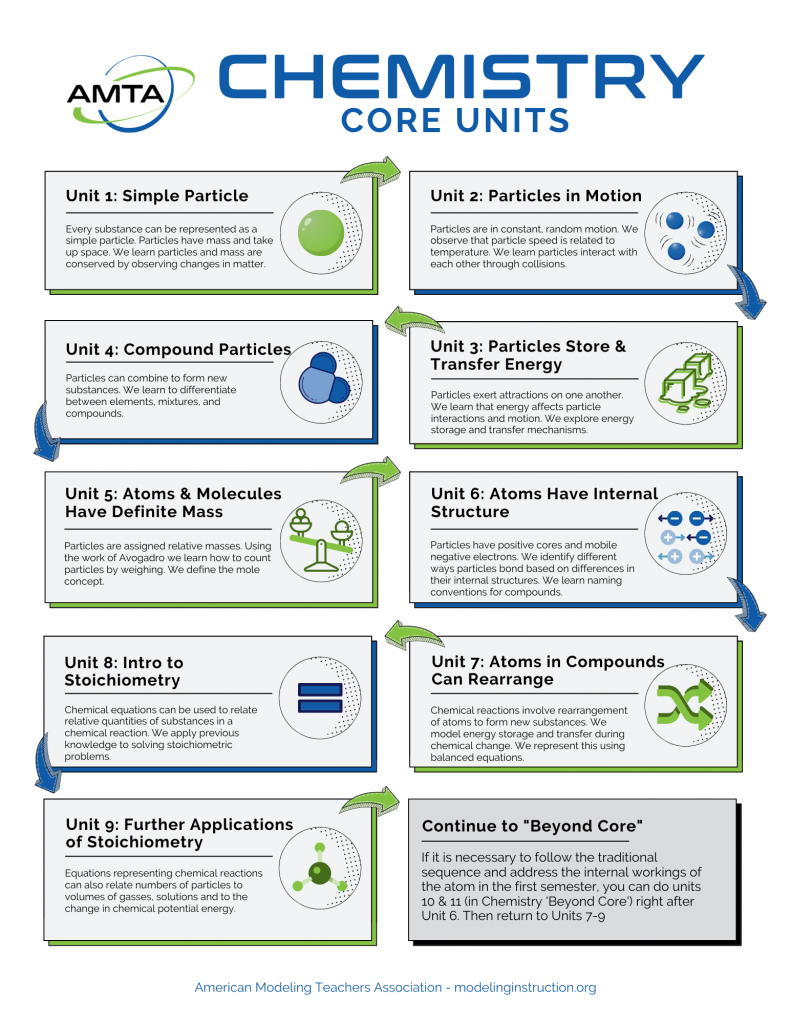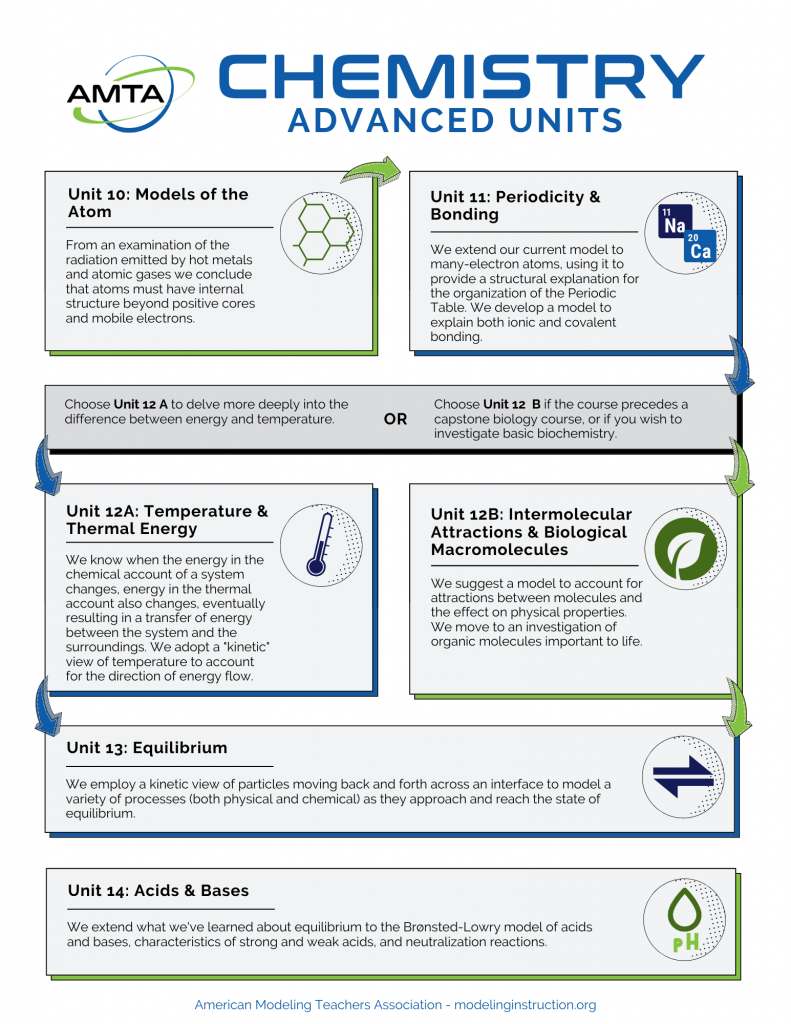Brief History
Since the summer of 1999, groups of modeling teachers have worked at Arizona State University to organize the topics students ordinarily study in high school (and introductory college) chemistry around a series of particle models of increasing complexity. In 2005 we began an effort to develop a Modeling Workshop for chemistry with a design parallel to that used in the Modeling Workshop in mechanics. In June 2005 we conducted a pilot workshop in chemistry at ASU. Since then nearly 2500 teachers have taken Modeling Chemistry workshops nationwide.
Chemistry Storylines
Download a PDF file of the Chemistry Storylines.


Our Approach
The curriculum design was influenced by the CHEM-Study approach which first appeared in the early 60’s. Our work makes the particle models used to describe matter and the treatment of the role of energy in change more explicit. The three questions that guide our approach to understanding chemistry are:
- How do we view matter? (Answer in terms of the particle model you are using to describe matter)
- How does it behave? (Provide an explanation of the behavior using this particle model)
- What is the role of energy in the changes we observe?
Sequencing
In traditional chemistry curricula, students are introduced right away to the modern model of the atom and asked to accept all its complexities as a matter of faith. By contrast, our approach is to start with a simple model of the atom and show students that our model evolves as the need for a better one arises. In each of the instructional units we follow this sequence:
- Examining phenomena
- Describing patterns we impose on the phenomena
- Building the models to help us explain phenomena
Our treatment of the role of energy in both physical and chemical change is sufficiently different from the piecemeal approach found in most curricula that you will want to review it pretty thoroughly before you attempt to teach it. We have also included two evaluation instruments:
- The Matter Concept Inventory is an assessment of student understanding of the particle nature of matter. It was originally intended for use with an 8th-9th grade physical science course.
- The Assessment of Basic Chemistry Concepts (ABCC) is adapted from the Chemical Concepts Inventory developed by Doug Mulford (JChemEd-2002). We have modified it to make it more appropriate for use with high school students.
The slide show exhibits the storyline we have used to uncover chemistry. The curriculum materials have undergone testing at our high schools for ten years and have been used in workshops since 2005. Major contributors include Joy Shrode, Brenda Royce, Larry Dukerich, Ray Howanski, Tammy Gwara and Dr. Guy Ashkenazi. If you have any questions, comments or concerns, you should direct them to Larry Dukerich or Brenda Royce.
Article describing Modeling Instruction in chemistry
Sample Materials
Follow this link for sample materials from Chemistry Unit 2 — Energy and States of Matter Part 1. Note that this sample unit does NOT contain any quizzes or tests, and addresses the following objectives:
- Relate observations regarding the addition of energy by warming to increased particle motion.
- Describe the characteristics of solids, liquids and gases in terms of particles and their arrangement, attraction, and behavior.
- Recognize energy as a conserved, substance-like quantity that is always involved when a system undergoes change.
- Recognize that energy is stored in an object or system in several ways; for now we restrict our discussion to thermal energy (due to the motion of the particles) and phase energy (due to the arrangement of the particles in solid, liquid and gaseous phases).
- Describe the ways that energy is transferred between the system and the surroundings via heating, working, or radiating.
- Draw energy bar graphs to account for energy storage and transfer in all sorts of changes. Make up a sample situation and sketch the bar graph.
- Given a heating/cooling curve for a substance, identify what phase(s) is/are present in the various portions of the curve, and what the melting and freezing temperatures for the substance are.
- Given a heating/cooling curve for a substance, identify which energy storage mode is changing for the various portions of the curve.
- Given a situation in which a substance at a given temperature undergoes a change (in temperature, phase or both), sketch a heating/cooling curve that represents the situation.
- State the physical meaning of the heat of fusion (Hf) and heat of vaporization (Hv) for a given substance and use these factors to relate the mass of a substance to the energy absorbed or released during a phase change (at the melting or boiling temperature).
- State the physical meaning of the heat capacity (c) of a substance and use this factor to relate the mass and temperature changes to the energy absorbed or released during a change in temperature (with no phase change).
Interested in a Chemistry Workshop?
First-time Modeling Workshop attendees qualify for a free one-year membership to AMTA. Members have access to ALL instructional resources, webinars, distance learning courses, and other membership services!AMTA members have access to ALL instructional resources, webinars, distance learning courses, and other membership services!
